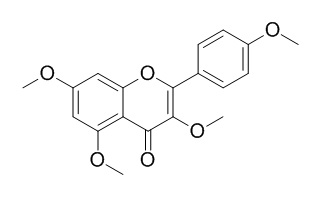Tetramethylkaempferol
Tetramethylkaempferol is a PPARγ agonist, it can improve insulin sensitivity by increasing the levels of adiponectin, an important adipocytokine associated with insulin sensitivity in adipose tissue. Tetramethylkaempferol can concentration-dependently enhance the accumulation of triglyceride, a marker of adipogenesis.
Inquire / Order:
manager@chemfaces.com
Technical Inquiries:
service@chemfaces.com
Tel:
+86-27-84237783
Fax:
+86-27-84254680
Address:
1 Building, No. 83, CheCheng Rd., Wuhan Economic and Technological Development Zone, Wuhan, Hubei 430056, PRC
Providing storage is as stated on the product vial and the vial is kept tightly sealed, the product can be stored for up to
24 months(2-8C).
Wherever possible, you should prepare and use solutions on the same day. However, if you need to make up stock solutions in advance, we recommend that you store the solution as aliquots in tightly sealed vials at -20C. Generally, these will be useable for up to two weeks. Before use, and prior to opening the vial we recommend that you allow your product to equilibrate to room temperature for at least 1 hour.
Need more advice on solubility, usage and handling? Please email to: service@chemfaces.com
The packaging of the product may have turned upside down during transportation, resulting in the natural compounds adhering to the neck or cap of the vial. take the vial out of its packaging and gently shake to let the compounds fall to the bottom of the vial. for liquid products, centrifuge at 200-500 RPM to gather the liquid at the bottom of the vial. try to avoid loss or contamination during handling.
Nutrients2023, 15(18), 4016.
Korean Journal of Pharmacognosy2019, 50(4):285-290
Food Chem Toxicol.2020, 135:110863
Regen Biomater.2023, 10:rbad077.
FEBS Lett.2021, 595(20):2608-2615.
J Agric Food Chem.2018, 66(1):351-358
Sci Rep.2020, 10:4495(2020)
Journal of Third Military Medical University2018, 40(12):1073-1078
Int J Biol Macromol.2019, 126:653-661
Plant Cell, Tissue and Organ Culture (PCTOC)2020, 143, 45-60(2020)
Related and Featured Products
Biol Pharm Bull. 2014;37(6):884-91.
Search for new type of PPARγ agonist-like anti-diabetic compounds from medicinal plants.[Pubmed:
24882400]
METHODS AND RESULTS:
Potent ligands of peroxisome proliferator-activated receptor γ (PPARγ) such as thiazolidinediones (pioglitazone, troglitazone, etc.) improve insulin sensitivity by increasing the levels of adiponectin, an important adipocytokine associated with insulin sensitivity in adipose tissue. Several constituents from medicinal plants were recently reported to show PPARγ agonist-like activity in 3T3-L1 cells, but did not show agonistic activity at the receptor site different from thiazolidinediones.
CONCLUSIONS:
Our recent studies on PPARγ agonist-like constituents, such as hydrangenol and hydrangeic acid from the processed leaves of Hydrangea macrophylla var. thunbergii, piperlonguminine and retrofractamide A from the fruit of Piper chaba, and Tetramethylkaempferol and pentamethylquercetin from the rhizomes of Kaempferia parviflora, are reviewed.
Arch Pharm Res. 2004 Mar;27(3):300-4.
Antioxidant caffeic acid derivatives from leaves of Parthenocissus tricuspidata.[Pubmed:
15089035]
METHODS AND RESULTS:
Five caffeic acid derivatives; methyl ester of caffeoylglycolic acid (1), dimethyl ester of caffeoyltartaric acid (2), dimethyl ester of caffeoyltartronic acid (3), monomethyl ester of caffeoyltartronic acid (4), methyl ester of caffeic acid (5), and some other secondary metabolites including; quercetin, quercetin 3-O-beta-D-glucuronide methyl ester, kaempferol, 3,5,7,4'-O-Tetramethylkaempferol, beta-sitosterol glucoside, 2alpha-hydroxyursolic acid and 2,24-dihydroxyursolic acid, have been isolated and characterized. All the isolated compounds were characterized with the help of NMR spectroscopy and mass spectrometry. Structure of compound 3 was also confirmed by a single X-ray crystallographic technique.
CONCLUSIONS:
Isolates were evaluated for antioxidant activities and most of the tested compounds were found to be potent in DPPH free radical scavenging (IC50 = 4.56-14.17 microg/mL) and superoxide anion scavenging (IC50 = 0.58-7.39 microg/mL) assays.
Bioorg Med Chem. 2011 May 1;19(9):2835-41.
Structural requirements of flavonoids for the adipogenesis of 3T3-L1 cells.[Pubmed:
21493073]
To search for a new class of antidiabetic compounds, effects of 44 flavonoids on the adipogenesis of 3T3-L1 cells were examined.
METHODS AND RESULTS:
Among them, 3,4',7-trimethylkaempferol, Tetramethylkaempferol, and pentamethylquercetin concentration-dependently enhanced the accumulation of triglyceride, a marker of adipogenesis.
With regard to structural requirements of flavonoids for the activity, it was fond that: (1) most flavonoids having hydroxy groups lacked the effect; (2) flavonols with methoxy groups showed stronger effects particularly those with a methoxy group at the 3-position; and (3) a methoxy group of flavonols at the B ring was also important. 3,4',7-Trimethylkaempferol, Tetramethylkaempferol, and pentamethylquercetin significantly increased the amount of adiponectin released into the medium and the uptake of 2-deoxyglucose into the cells. Furthermore, Tetramethylkaempferol and pentamethylquercetin also increased mRNA levels of adiponectin, glucose transporter 4 (GLUT4), and fatty acid-binding protein (aP2). Both compounds also increased the mRNA levels of peroxisome proliferator-activated receptor (PPAR)γ2 and CCAAT/enhancer-binding protein (C/EBP)α, β, and/or δ, although, different from troglitazone, they did not activate PPARγ directly in a nuclear receptor cofactor assay.



